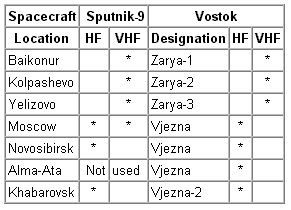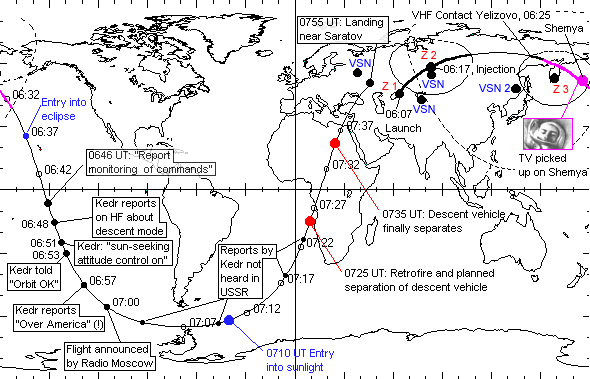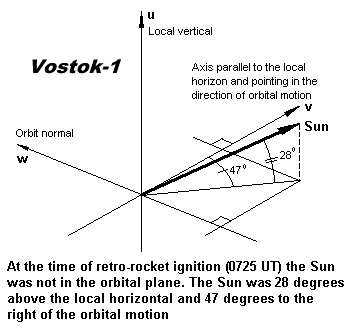 An analysis of the flight of Vostok
An analysis of the flight of Vostok
 An analysis of the flight of Vostok
An analysis of the flight of Vostok
 Tracking
stations used for the flight
Tracking
stations used for the flightPart of our knowledge of the location of ground stations for the Vostok series is based on General Kamanin's diary (1) in which we can read for 6 March 1961:
"...the commission accepted my proposal about the organization of control points for the flight in Moscow (TsPUP), Tyura-Tam, Novosibirsk, Kolpashevo, Khabarovsk and Yelizovo (Kamchatka). Moscow will have shortwaves and VHF communications with the spacecraft (if it makes more than one orbit), Tyura-Tam, Kolpashevo and Yelizovo will have VHF only, but Novosibirsk and Khabarovsk only shortwaves. Radius of contact for shortwaves is 5000 km and 1500 km for VHF. These radii thus far have not been practically checked and it is not yet certain that communications will be reliable, especially during the phase between launch and orbital insertion. At every KP (Command Point) there will be a KP chief, a communications officer, a cosmonaut, a doctor and a representative of the Ministry of Communications. ..."
 In
the table on the right the Sputnik-9 ground stations and the ground
stations
for Vostok from (2) are shown:
In
the table on the right the Sputnik-9 ground stations and the ground
stations
for Vostok from (2) are shown:
The Vesna station in
Alma-Ata
has been added to the station network of Sputnik-9. The reason that we
know that the designation Vesna-2 stands for Khabarovsk is the
following
entry for the 16 August 1962 in the diary of N.P. Kamanin's (1):
".....During
his flight Nikolayev reported about the radio communications: The
communications
worked well and was stable all the time. The best of all worked Vesna-2
(Khabarovsk), Vesna-1 and Vesna-6....."
| Station | Musical theme | Music transmitted | Kedr received by station? |
|---|---|---|---|
| Novosibirsk | Not known | 0622-0639 | No |
| Khabarovsk | "Waves of the Amur" | 0642-0652 | 0653-0657 two-way comms, signals heard from 0621 |
| Alma-Ata | Baglanova songs | 0652-0702 | No |
| Moscow | Songs about Moscow | 0703-0737 | Yes, at 0713 briefly |
Since the music was
transmitted
to give Gagarin a chance to judge the chances of communicating with a
particular
ground station it seems that duplex was used.
The map
below gives the landing time as officially announced in 1961. We now know that
touchdown of the descent module occurred at: 0748 UT and the touchdown of the
pilot occurred at 0753 UT (7)..

 Contact
with the launch site (Zarya-1)
Contact
with the launch site (Zarya-1)Chris van den Berg has provided a translation and I have tried to correlate his translation to the transcripts in (2) and (3).
"I understood that. I heard in the .......(unclear) ... worked very well. My general state is excellent. All is working well. I hear you loud and clear."
0613 UT:
"
.. the flight is continuing well. I can see the earth. The visibility
is
good. ... I almost see everything. There's a certain amount of
space
under cumulus cloud cover. I continue the flight, everything is
good."
0614 UT:
"All
is working very well. All systems are working. Let's keep going!"
0615 UT:
"Zarya-1,
Zarya-1, I can't hear you very well. I fel fine. I'm in good spirits.
I'm
continuing the flight....."
"...the lights are on on the descent mode monitor. I'm feeling fine, and I'm in good spirits. Cockpit parameters: pressure 1; humidity 65; temperature 20; pressure in the compartment 1; first automatic 155; second automatic 155; pressure in the retro-rocket system 320 atmospheres...."
 It
is interesting that in the middle of this contact, at 0626 UT, Vostok
rose
above the horizon at the U.S. ELINT station on Shemya where a readout
of
the TV images of Gagarin took place (see article "TV
from Vostok") (5). TV transmissions
from
Vostok are not mentioned in (2), (3),
or (4), except that in (3)
Gagarin mentions that he has switched on the TV lights. However, in (6)
it is mentioned that "in additon, a television camera has been
installed
in the cockpit of the satellite craft so taht the cosmonaut can be
observed
when the craft is within line-of-sight from the Soviet Union....". (The
picture on the right is a heavily retouched TV picture of Gherman Titov
from onboard Vostok-2.)
It
is interesting that in the middle of this contact, at 0626 UT, Vostok
rose
above the horizon at the U.S. ELINT station on Shemya where a readout
of
the TV images of Gagarin took place (see article "TV
from Vostok") (5). TV transmissions
from
Vostok are not mentioned in (2), (3),
or (4), except that in (3)
Gagarin mentions that he has switched on the TV lights. However, in (6)
it is mentioned that "in additon, a television camera has been
installed
in the cockpit of the satellite craft so taht the cosmonaut can be
observed
when the craft is within line-of-sight from the Soviet Union....". (The
picture on the right is a heavily retouched TV picture of Gherman Titov
from onboard Vostok-2.)
Gagarin keeps asking for data on the flight as his craft approaches the horizon at Zarya-3, but the ground has difficulty hearing him: "I feel splendid, very well, very well, very well. Give me some results on the flight!" Zarya-3 replies: "Repeat. I can't hear you very well". Gagarin comes back to say: "I feel very good. Give me your data on the flight!" After that VHF contact is lost with Vostok.
"I am transmitting the regular report message: 9 hours 48 minutes (Moscow Time), the flight is proceeding successfully. Spusk-1 is operating normally. The mobile index of the descent mode monitor is moving. Pressure in the cockpit is 1; humidity 65; temperature 20; pressure in the compartment 1.2 .... Manual 150; First automatic 155; second automatic 155; retro rocket system tanks 320 atmospheres. I feel fine...".
Shortly after he reported entering eclipse (0649 UT) and not hearing the ground, but Vesna heard him. At 0651 UT Gagarin reported that the sun-seeking attitude control system had been switched on and Vesna picked up that message also.
Finally, at 0653 UT Khabarovsk transmits the message that Gagarin has been waiting for:
"By order of No.33 (Kamanin) the transmitters have been switched on, and we are transmitting this: the flight is proceeding as planned and the orbit is as calculated." This message is repeated a minute later and Gagarin acknowledges the message.
The final message picked up by Khabarovsk at 0657 UT is slightly erroneous as to the whereabouts of the spacecraft:
"....I'm continuing the flight, and I'm over America. I transmitted the telegraph signal "ON" (The equipment is operating normally)
Actually Vostok was over the South Pacific approaching the southern tip of South America.....
Gagarin kept
transmitting
his reports at 0704 UT, 0709:15 UT, 0718 UT, and 0723 UT, but they were
not picked up by ground stations. Only a brief transmission was picked
up in Moscow at 0713 UT: "I
read you well. The flight is going...".

Another
possibility would have been to use ionic
sensors to provide a yaw reference. In such a case the sun would
not
have been needed as an attitude reference. However, I think that the
ionic
sensors were first flown on Voskhod-1 and its test flights. Therefore,
Vostok was forced to rely on an an earth-sun attitude reference system.